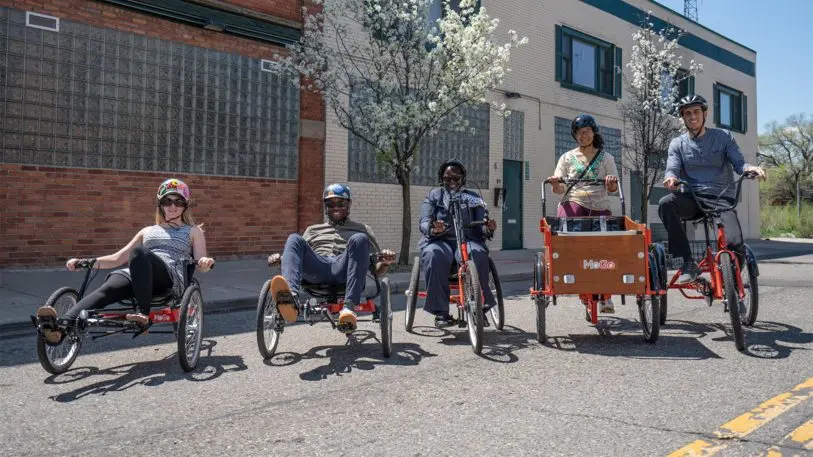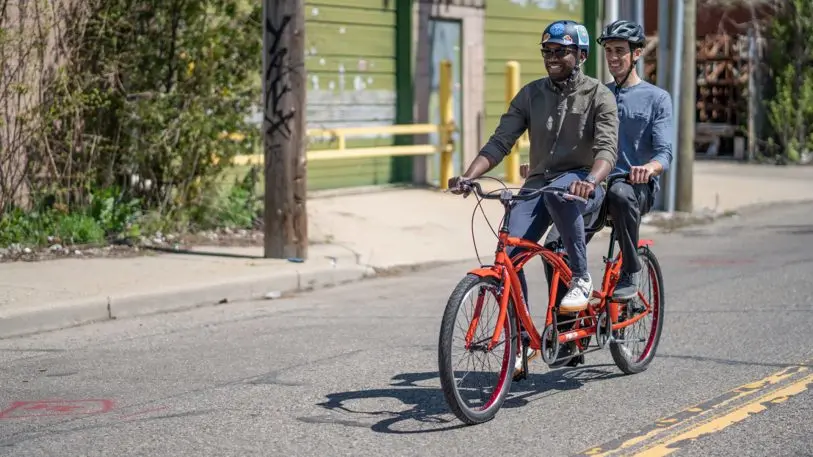MoGo, Detroit’s bike-share system, launched in 2017. But a couple years before, when it was still in the planning phases, Lisa Nuszkowsi, MoGo’s founder and executive director, got a call from John Waterman, who heads up a Ypsilanti-based nonprofit initiative called Programs to Educate All Cyclists. PEAC helps people with disabilities learn to ride bikes and use cycling as a means of empowerment and self-transportation, and Waterman wanted to know how Nuszkowski planned to make bike sharing accessible to people of all abilities.
“I said: ‘That’s a great question–what are we going to do?'” Nuszkowski tells Fast Company. She proposed working with Waterman to find a solution, and the result of that collaboration–a fleet of adaptive bicycles–launched as a pilot program May 15.

The adaptive MoGo program comprises 13 specially designed bikes. There’s a tricycle that users can pedal with their hands; this option is particularly beneficial to people with limited mobility below the waist. The cargo bike contains enough space in the front attachment for a passenger with mobility impairments to sit comfortably while someone pedals behind them; it’s also workable for parents of small children or service-dog owners who want to bring them along for a ride. And there are several tandem bike options that allow riders who may have issues with vision or balance to experience the benefits of cycling while having someone help steer in the front.
For the duration of the pilot program, which runs through October, people can rent out the bikes at a local shop, Wheelhouse Detroit, which sits right along the city’s popular Riverwalk greenway path. A single day pass on one of the bikes is $12, or users can buy a season pass for $30 and get unlimited use (based on availability) during that time. Either way, users have to first reserve a bike online. “It functions more like a bike rental,” Nuszkowski says. It’s very different from the standard MoGo model, where users check out bikes independently at one of the city’s 43 docks for $8 a day. But after hosting numerous focus groups with members of the disability community, “the feedback that we heard was that many people have mobility devices that they use, whether it be a wheelchair or a cane, and having a place to store that is really useful,” she adds.

Proximity to safe, dedicated bike infrastructure, too, will allow users to test out the bikes without the pressure of having to navigate through urban streets. Nuszkowski says that people they spoke to were most interested in using the adaptive MoGos for recreational purposes, like taking a ride down the Riverwalk, rather than using them for running errands, so they structured the pilot accordingly. The model of integrating adaptive cycles into bike-share programs by partnering with local shops near safe bike routes is something that started in Portland–their Adaptive Biketown pilot launched last year.
The Adaptive MoGo is small in scope–13 bikes will by no means reach everyone in Detroit’s disability community at once. What MoGo wants to prove and research is the demand for this type of initiative, how riders want to use it, and how best to scale. “We’re definitely viewing this as a learning year,” Nuszkowski says. Even with all the pre-launch feedback MoGo has sourced, “how people think they might use the bikes and how they actually will use them could be totally different,” she adds. They’ll continue to source feedback from users and make tweaks as the pilot progresses–Nuszkowski says she could see adding some more pickup-dropoff locations, or tweaking the rental structure to offer some more intermediary options, like a week-long pass.
From a financial perspective, it’s important that MoGo be very deliberate in looking to scale the program. The bikes are difficult to source and expensive–cargo bikes, for instance, can cost over $2,000–so MoGo wants to see which are most useful to people before fully investing in a larger fleet (they secured grants to finance the currently available adaptive cycles). “There’s definitely a gap in the market,” Nuszkowski says. “We heard some early feedback that the program provides people an opportunity to ride that they wouldn’t otherwise have.” They’ll bring the user data collected over the course of the pilot to their funders in October to potentially secure capital to expand the Adaptive MoGo program.
Now seems to be the ideal time for Detroit to launch this inclusive bike-share option. “We have a really active and engaged city government in terms of building out infrastructure that supports safe biking,” Nuszkowski says. Rolling out this fleet of adaptive cycles, which are often wider and less agile than regular bikes, could create added awareness around the need to make bike routes that are truly safe and accessible.

While most mobility services for people with disabilities in cities center around accessible vehicles like buses or dedicated ride-sharing programs, expanding the reach of adaptive cycles could add a more sustainable option to the mix, but one that requires the support of good infrastructure–and eventually, if it scales, consideration for where the larger fleet of cycles could be stored. “Adaptive bikes are of unique shape and design and they wouldn’t necessarily be able to fit into our current stations because they’re too wide or long, and protrude further into the right-of-way,” says Rory Lincoln, MoGo’s director of programming and operations. That’s not a reason, though, to balk at expanding their presence. “Both for manufacturers and equipment providers, and streetscape designers generally, hopefully, this will start a new conversation around how to incorporate these bikes into what people know to be bike-share already,” he adds.
MoGo itself has boomed in popularity in its one year of existence–the system has notched over 130,000 rides, despite predictions of hitting just 100,000. But the company doesn’t want that growth to come at the expense of inclusivity. The new adaptive cycles are “a way for people to be a part of something that they see everybody else being a part of,” Nuszkowski says.
Recognize your brand’s excellence by applying to this year’s Brands That Matter Awards before the early-rate deadline, May 3.
